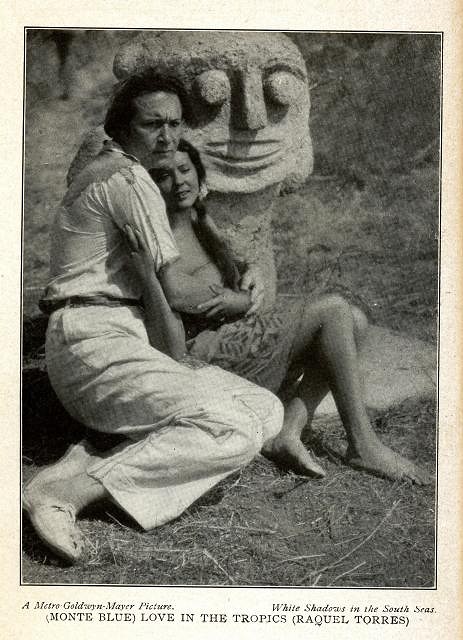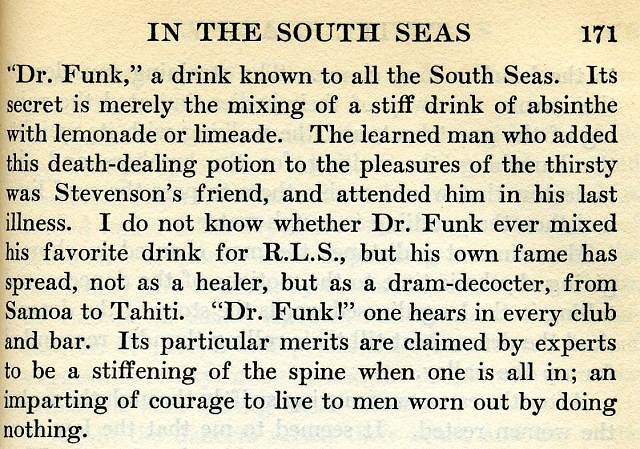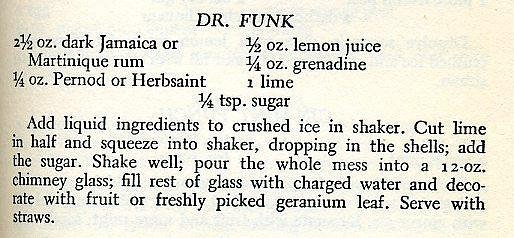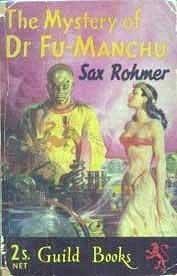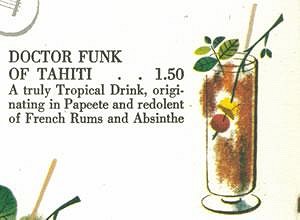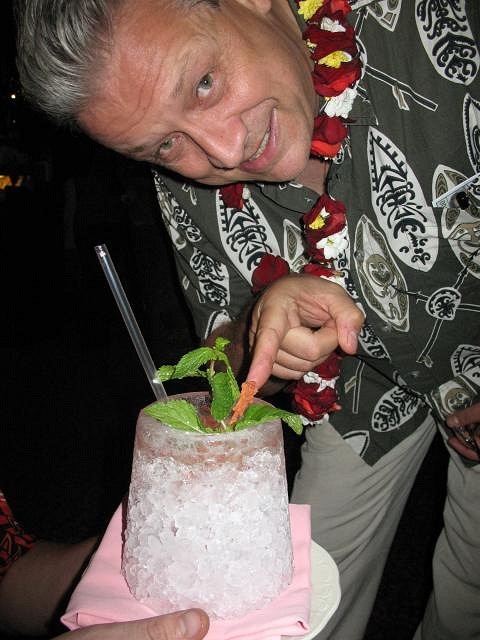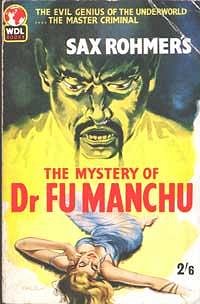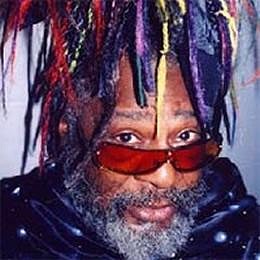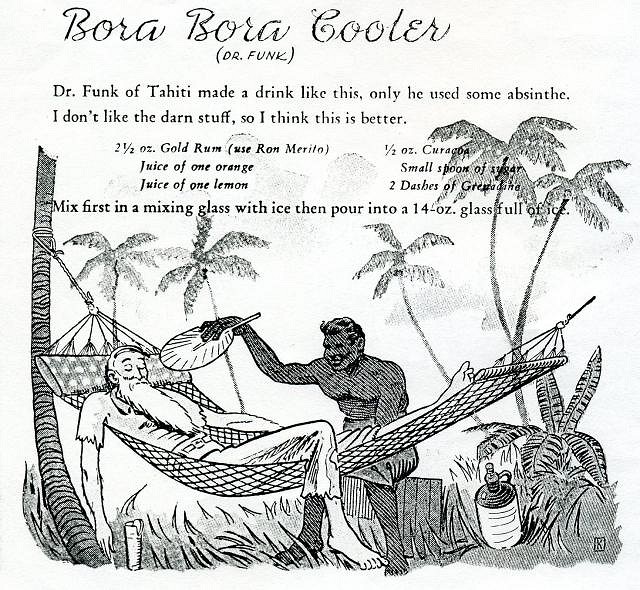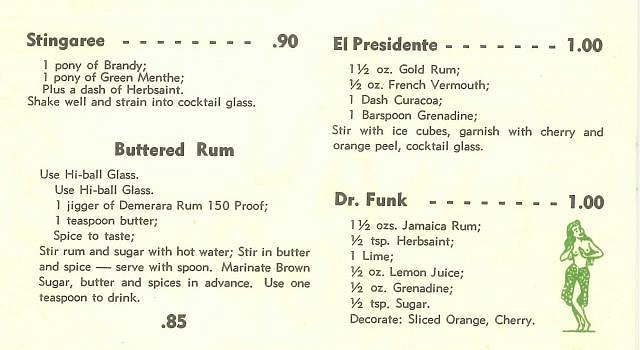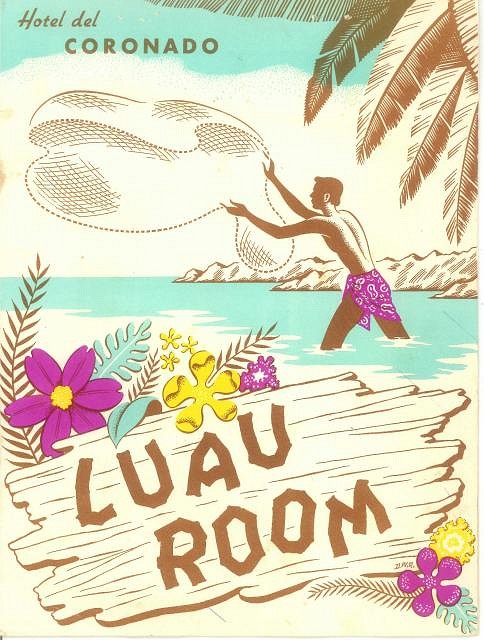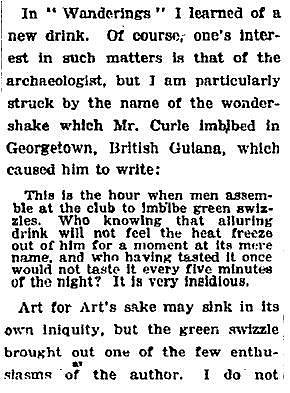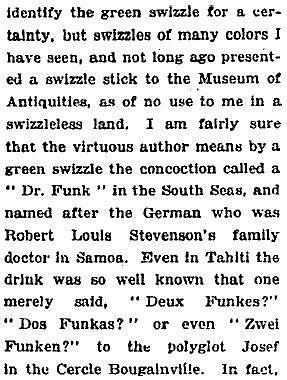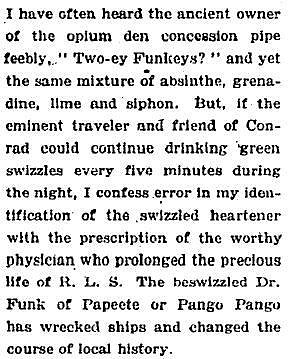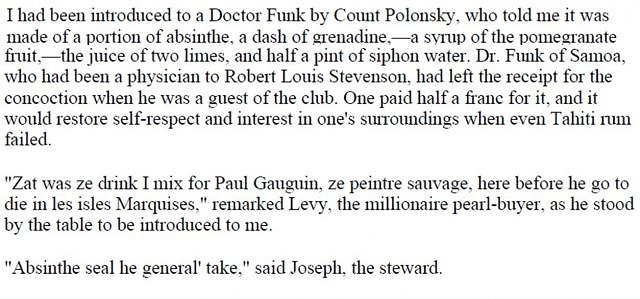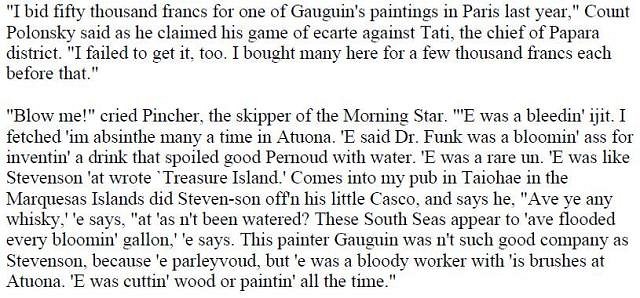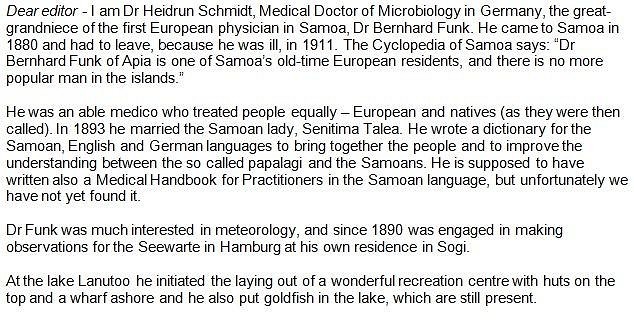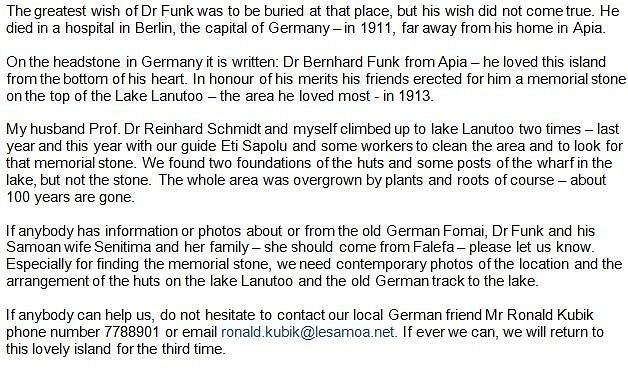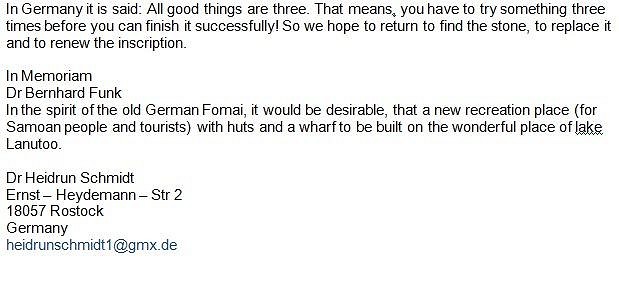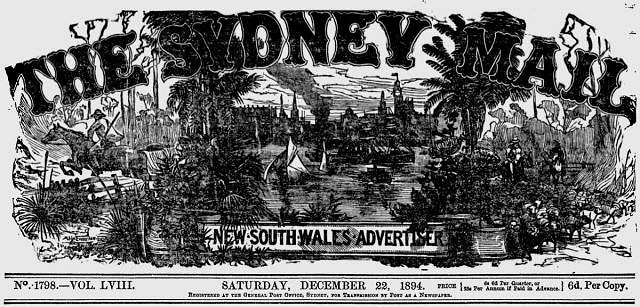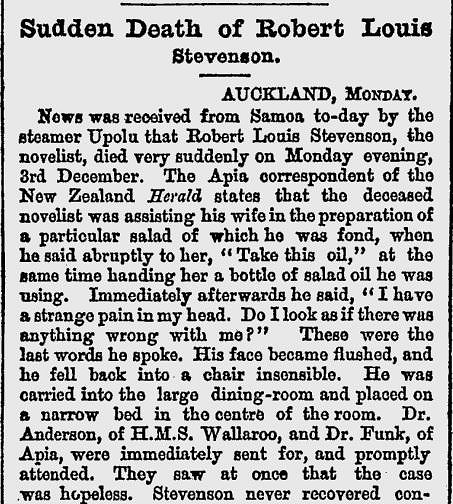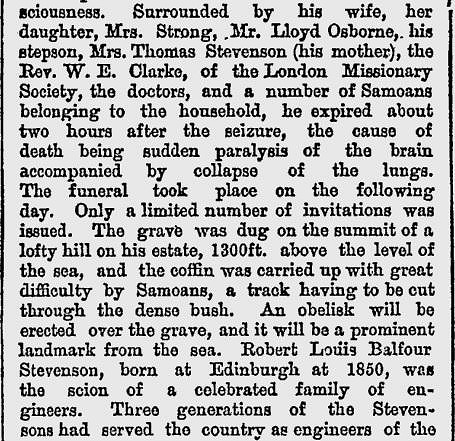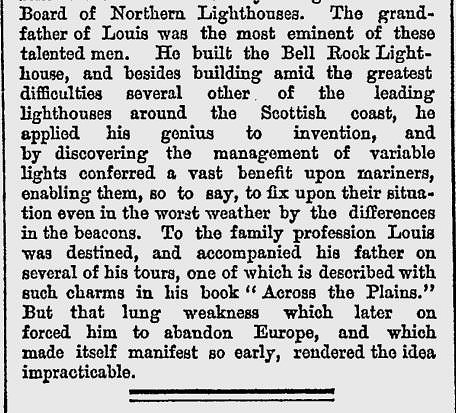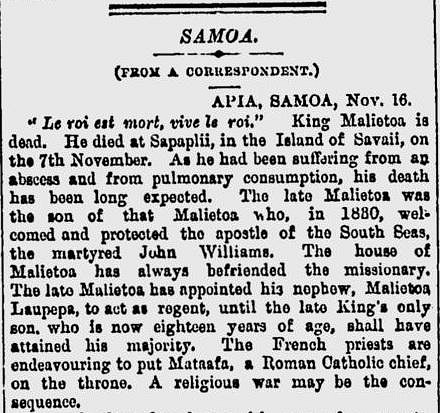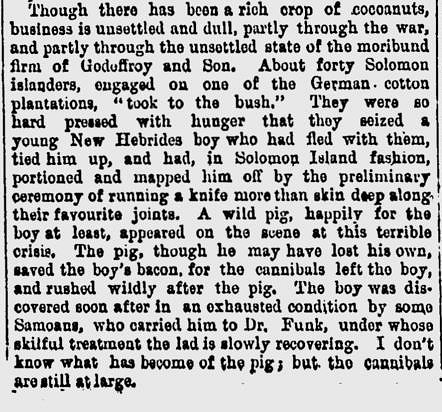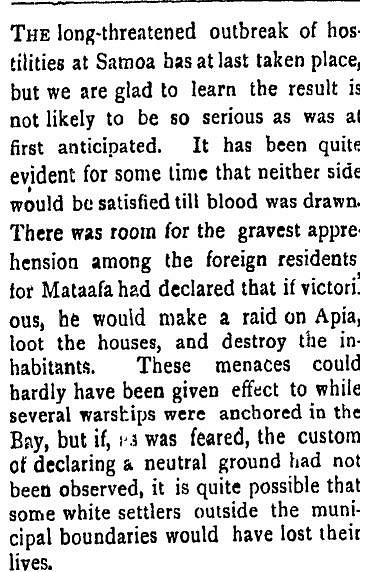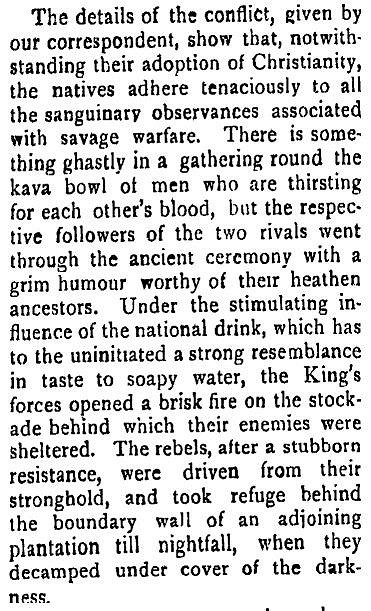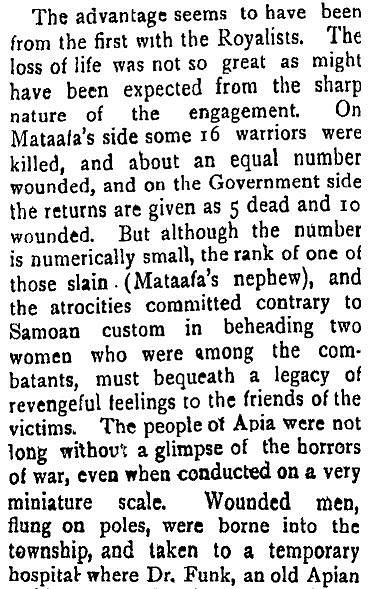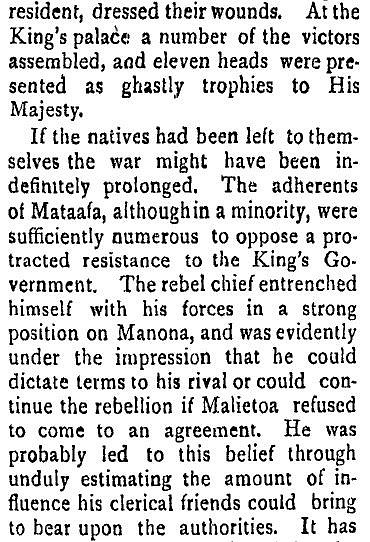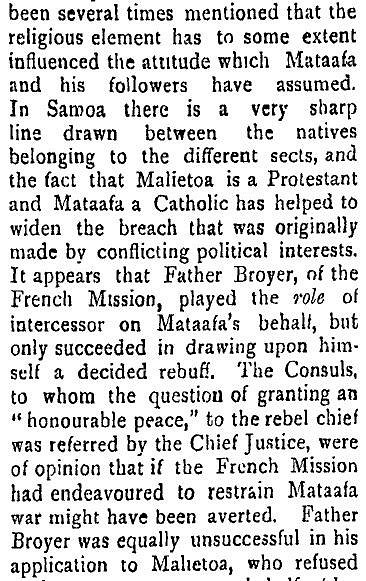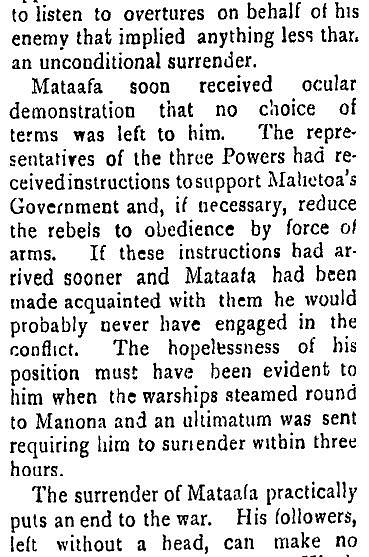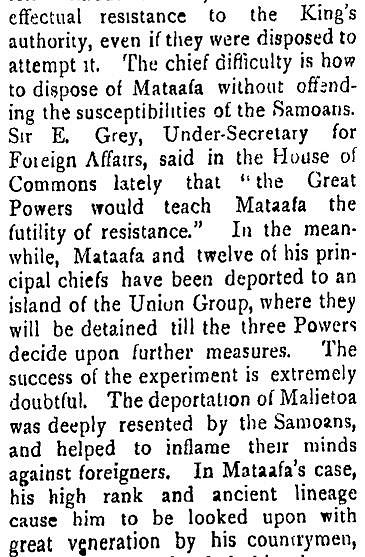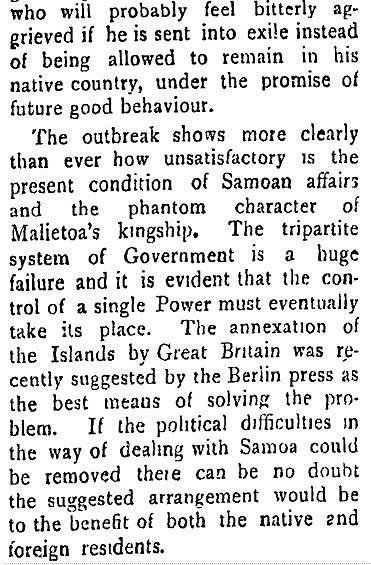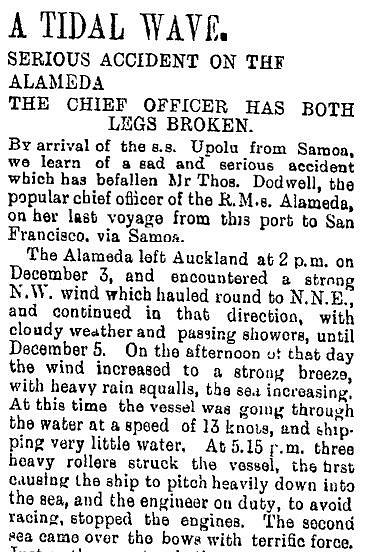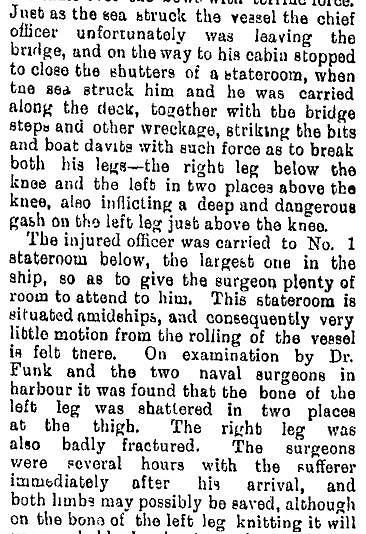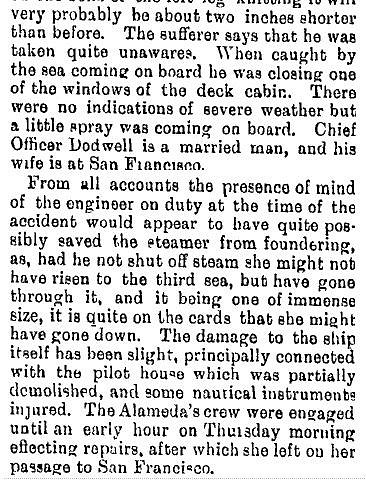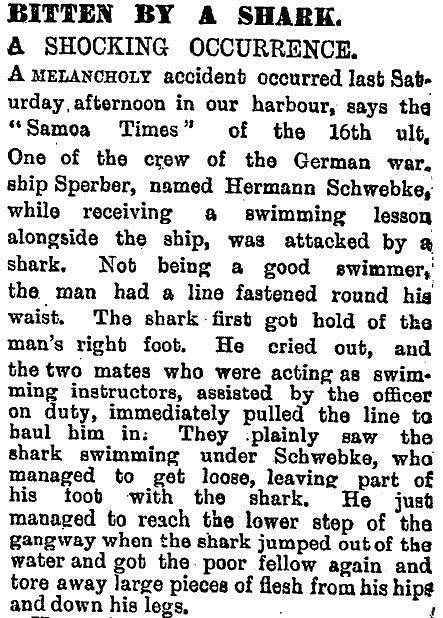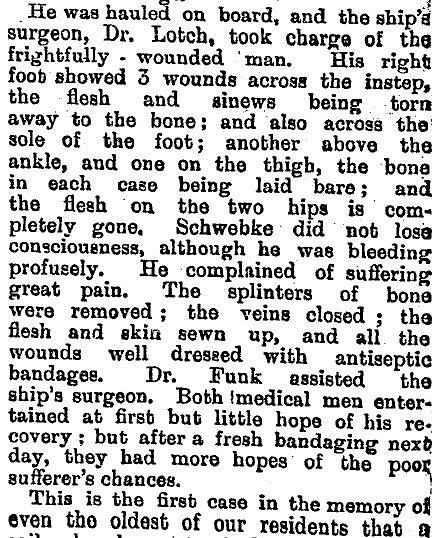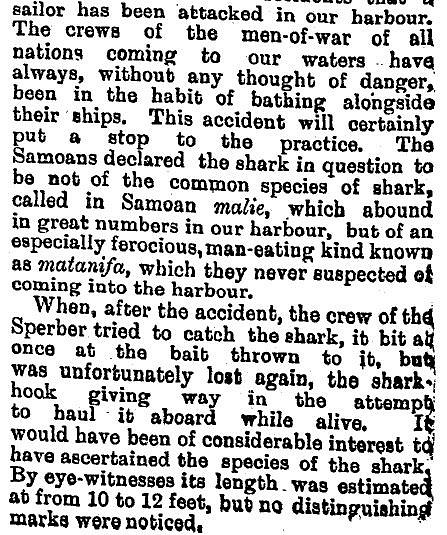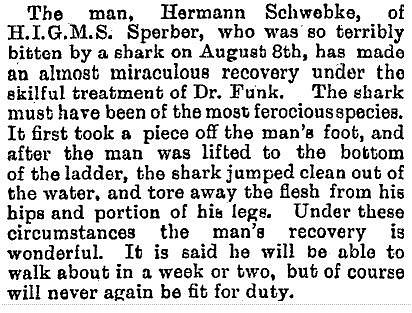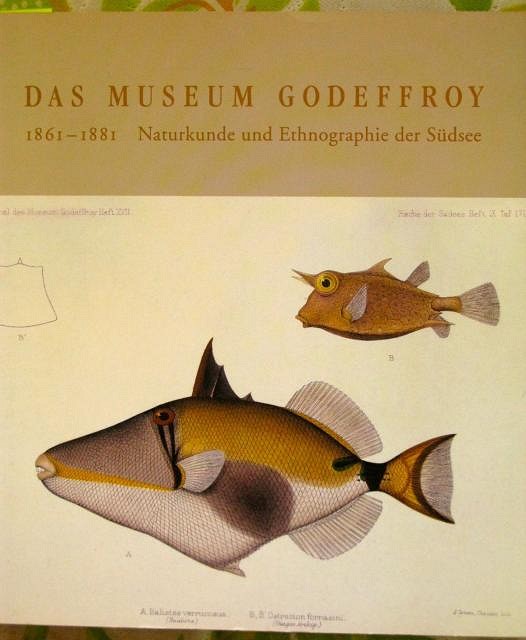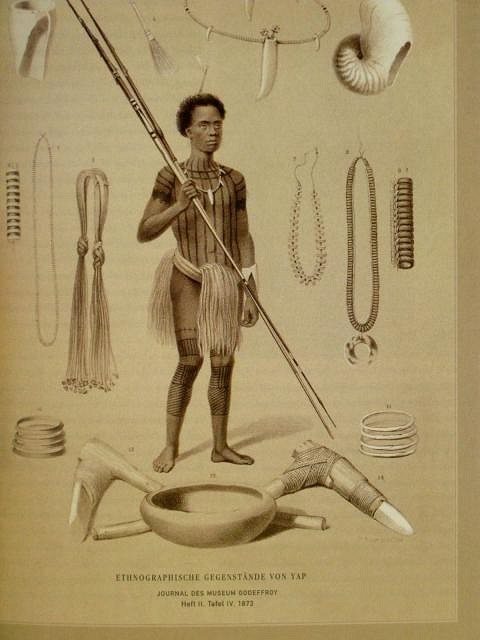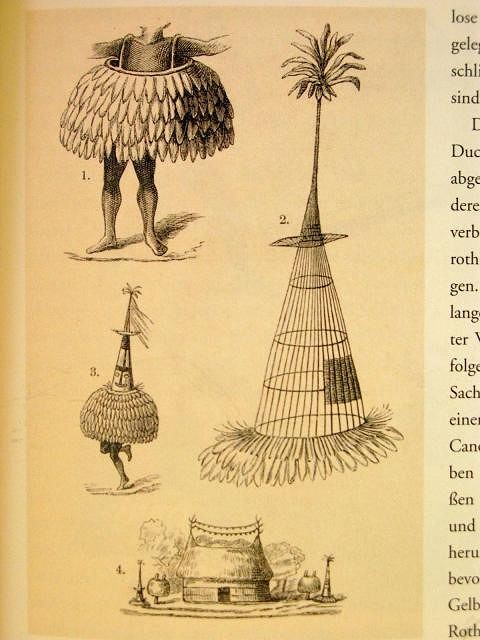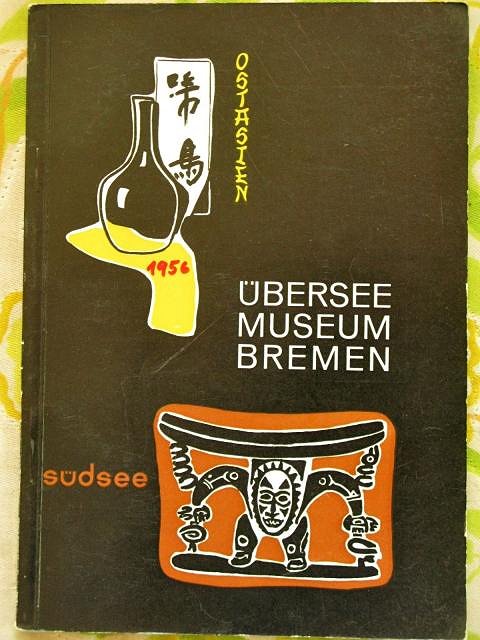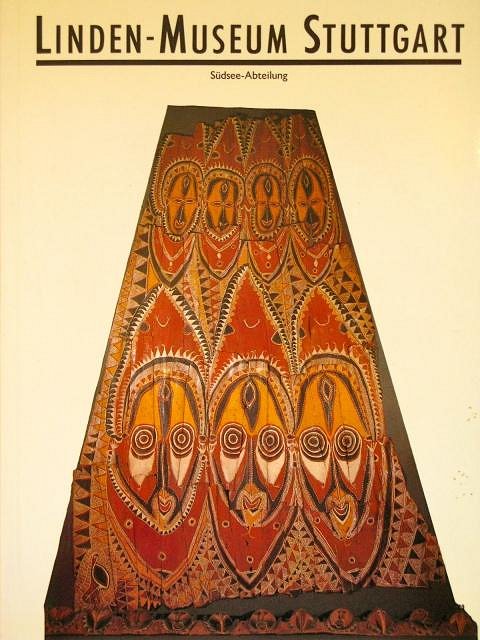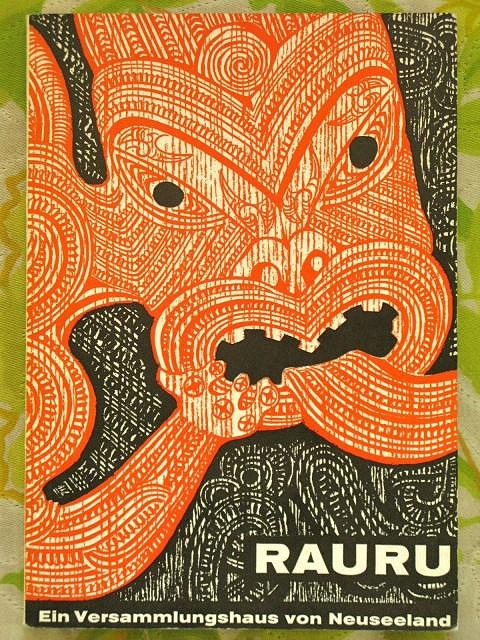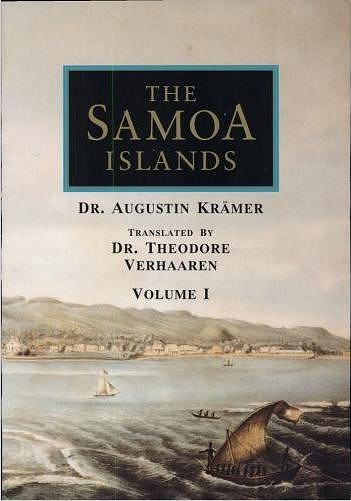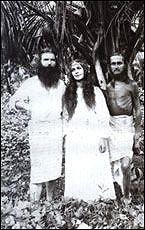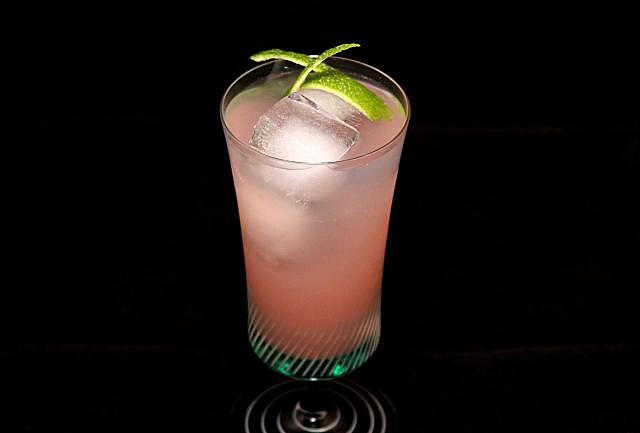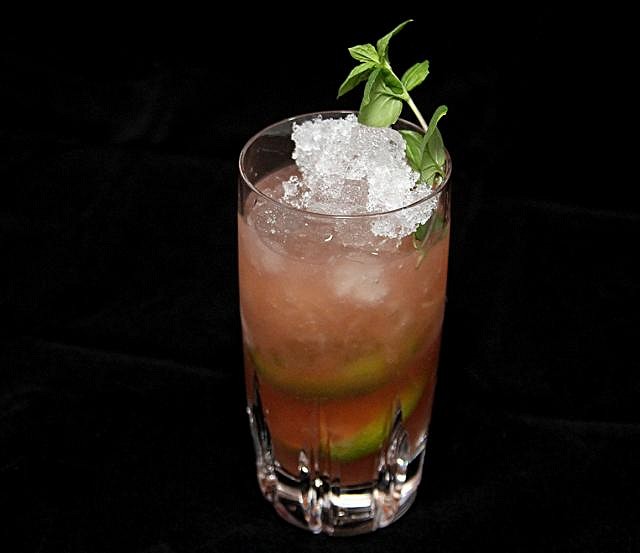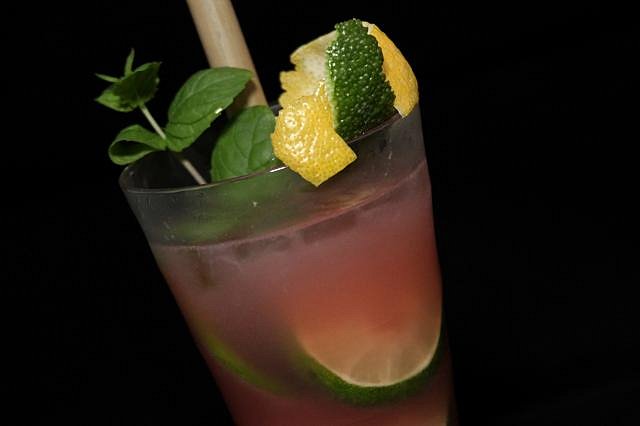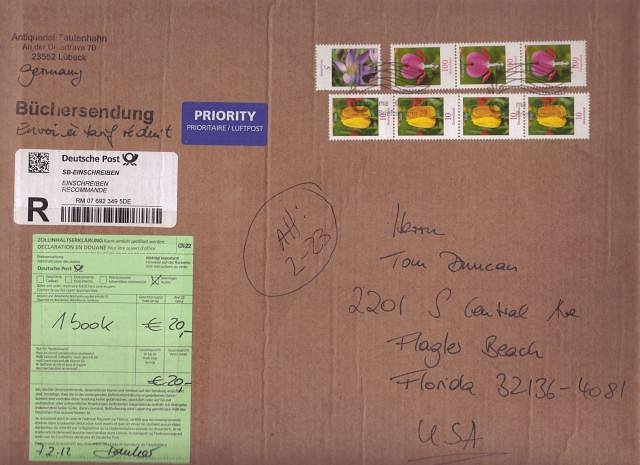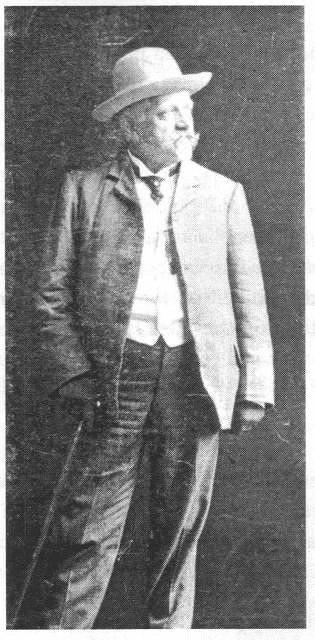Tiki Central / Tiki Drinks and Food
The real Dr. Funk
|
B
bigbrotiki
Posted
posted
on
Thu, Jul 10, 2008 12:16 AM
I do not dabble in cocktail research too much, because my friends Jeff Berry and Ted Haigh (and many others here) are far more advanced in the art and history of mixology than I will ever be. But sometimes during my Polynesian pop research I happen upon some curious info that had escaped even those formidable gentlemen so far. In this case it is from the early days of pre-Tiki Polynesian pop, from 1919. This post by Haole'akamai: http://www.tikicentral.com/viewtopic.php?topic=28914&forum=1 got me interested in the book "White Shadows in the South Seas". My 1919 printing did not have any of the clothing photos in it, but in the beginning I found what might be the earliest "South Seas Love Idyll with idol" photograph:
..so that was pretty cool. But leafing through the text, this passage jumped out at me:
Now to me the Dr. Funk cocktail had always been the unloved stepchild of Poly pop mixology, I just could not warm up to its licorice taste, and the mug being not Tiki. That was all I could gather, marveling at the fact that a cocktail ascribed to a German ended up being presented in a Fu Manchu mug. It is likely that the origin of the cocktail had already been forgotten by the time of the Tiki period. Unfortunately, I was unable to gather any more specifics about the inception and recipe of the potion. Your turn! |
|
B
bigbrotiki
Posted
posted
on
Thu, Jul 10, 2008 11:23 AM
OK, since everybody is just so mazed by this revelation that they are struck mute, here is the earliest recipe I could come up with, from my 1947 Trader Vic's Bar Guide:
...and here are two snippets of info I gleaned from Google:
|
|
B
Blowfish
Posted
posted
on
Thu, Jul 10, 2008 11:31 AM
I for one applaud your efforts! Very cool to have turned that up.... and much like you I have always wondered, why the fu-man-chu mug. It is time for a new Dr. Funk mug! |
|
BB
Bora Boris
Posted
posted
on
Thu, Jul 10, 2008 12:00 PM
I wonder if things got blurry early on between Dr. Funk and Fu Manchu since they were both Doctors?
Maybe they went to medical school together? :wink: It would be cool if there were a picture of Dr. Funk so we could see if he had any facial hair and how he wore it. |
|
G
GatorRob
Posted
posted
on
Thu, Jul 10, 2008 12:23 PM
Let's not forget that the good doctor apparently had a son too (Dr. Funk's Son), who, according to Trader Vic, was a "chip off the old block". He also has a distant cousin named Doctor Fong. This topic was partially discussed once before over here. The highlight of that thread concerning this cocktail comes from James T.:
|
|
C
cheekytiki
Posted
posted
on
Thu, Jul 10, 2008 12:38 PM
Dr Funks Son! Great thread Sven. |
|
M
MrBaliHai
Posted
posted
on
Thu, Jul 10, 2008 2:04 PM
That's essentially the same version that appears in da Bum's Intoxica!, which, oddly enough, he credits to Don the Beachcomber. Another drink recipe rip-off by that thievin' bastid Bergeron? In any case, now I know what I'm going to make after work tomorrow night.
[ Edited by: MrBaliHai 2008-07-10 14:04 ] |
|
R
rugbymatt
Posted
posted
on
Thu, Jul 10, 2008 2:36 PM
Auch du Lieber! |
|
TT
Trader Tiki
Posted
posted
on
Thu, Jul 10, 2008 4:11 PM
Interestingly enough, Trader Vic marks his Doctor Funk recipe in his "Book of Food and Drink" as a Trader Vic original. Perhaps he's referring to the recipe, which calls for plenty of Rum. Great find! |
|
M
MrBaliHai
Posted
posted
on
Thu, Jul 10, 2008 5:07 PM
Actually, I found it quite fascinating and gave you some nice props on my 'blog for your excellent discovery. |
|
M
MrBaliHai
Posted
posted
on
Thu, Jul 10, 2008 5:29 PM
There's a general description of the Doctor Funk recipe in the 1921 book, "Mystic Isles of the South Seas". Sounds quite similar to the '37 Don the Beachcomber version: "I had been introduced to a Doctor Funk by Count Polonsky, who told me it was made of a portion of absinthe, a dash of grenadine,—a syrup of the pomegranate fruit,—the juice of two limes, and half a pint of siphon water. Dr. Funk of Samoa, who had been a physician to Robert Louis Stevenson, had left the receipt for the concoction when he was a guest of the club. One paid half a franc for it, and it would restore self-respect and interest in one's surroundings when even Tahiti rum failed."
[ Edited by: MrBaliHai 2008-07-10 17:36 ] |
|
B
bigbrotiki
Posted
posted
on
Fri, Jul 11, 2008 10:03 AM
Well thank you Mr Bali Hai! For the mention, and for the additional research. That confirms what came through in my unearthed text, that there was no rum in the original, and that maybe one of those rummies Don or Vic added it later. Perhaps it will be delicious sans rum! And I think that Boris' suggestion can't be all wrong, the step from Dr. Funk to Dr. Fu is a small one...
...also considering that sometimes G.I.s referred to Polynesian restaurants as "Fu joints", probably because of their Chinese food offerings, the whole Jekyll and Hyde switch from German Dr. Funk (correctly pronounce "Foonk") to the Chinese Dr. Fu face mug seems likely. |
|
TG
The Gnomon
Posted
posted
on
Fri, Jul 11, 2008 12:50 PM
Anyone know what Bernard Funk looked like? Maybe he sported a Fu Manchu. I can find any pics of the guy yet. |
|
UB
Unga Bunga
Posted
posted
on
Fri, Jul 11, 2008 12:54 PM
On the island of Jive, Dr. Funk can also be pronounced;
(Sorry to derail Sven,I do like this thread :D) |
|
B
bigbrotiki
Posted
posted
on
Fri, Jul 11, 2008 1:37 PM
Unga, yo such a fu! |
|
B
bigbrotiki
Posted
posted
on
Fri, Jul 11, 2008 1:40 PM
I got as far as this: http://202.4.48.191/cgi-bin/koha/opac-search.pl?op=do_search&type=opac&marclist=∧_or=and&excluding=&operator=contains&value=Robert+Louis+Stevenson ...but I think one has to contact them and find out if they can scan a photo.... |
|
G
GatorRob
Posted
posted
on
Fri, Jul 11, 2008 1:47 PM
I can just see the confused look we're all going to receive next time we're in a Trader Vic's and order a "Doctor Foonk". Damn the Germans and their foonky pronunciations! :D |
|
B
bigbrotiki
Posted
posted
on
Fri, Jul 11, 2008 2:54 PM
...upon which we are gonna launch into this lengthy tirade about WHY this is correct, irrevocably outing ourselves as the Tiki know-it-all nerds we are! :D |
|
T
Tabu
Posted
posted
on
Sat, Jul 12, 2008 2:51 PM
I always wondered about that cocktail. Since I like my booze with a little history I'm off to make one. Cool thread. |
|
T
Tabu
Posted
posted
on
Sun, Jul 13, 2008 8:21 AM
Ok. I tried it and it was delicious. I am going to make it a regular at my house. Did not have any geranium leaves handy so that's something to try in the future. I'm not sure if that would add any scent or flavor to the whole experience but otherwise it was great. |
|
M
MrBaliHai
Posted
posted
on
Sun, Jul 13, 2008 2:30 PM
Did you make it without rum? |
|
T
Tabu
Posted
posted
on
Sun, Jul 13, 2008 8:14 PM
There was rum. Had to go with Goslings black. |
|
B
bigbrotiki
Posted
posted
on
Mon, Jul 14, 2008 4:00 PM
Here's even a Trader Vic's version that is rum only, completely mitout Absinthe, from a 1940s booklet that I lent someone and forgot who (boo hoo):
Vic knowingly changed it and thus renamed it. Even though (if the illustration is supposed to depict Dr. Funk) he seemed to had an inkling that the good Dr. was of Caucasian origin, I doubt he knew about the R.L. Stevenson connection, because he repeats the "Dr Funk of Tahiti" moniker, while we now know that the man lived and practiced in Samoa... Re-reading the text passage that I started this thread with: "But his fame spread...from Samoa to Tahiti..."Dr Funk" one hears in every club and bar.." It appears to me that the DRINK spread to Tahiti and became THE thing there, and so "Dr. Funk of Tahiti" is meant in regards to the cocktail, not the man. I asked Mr. Berry, and he believes that it was here that Don the B picked up the recipe, on one of his early travels. Which means A.) We now know more than Don and Vic did, and B.) We still need to find the original recipe, the one without rum. [ Edited by: bigbrotiki 2008-07-14 16:22 ] |
|
JD

Johnny Dollar
Posted
posted
on
Mon, Jul 14, 2008 7:09 PM
cool. we got the funk. |
|
B
bigbrotiki
Posted
posted
on
Mon, Jul 14, 2008 7:32 PM
Correct: "Rundfunk", and its abbreviation "Funk", means Radio (not the object, but the institution) A "Funker" is a radio operator. "Funken" as a verb means to radio, to transmit, and as a subject "Der Funken" it means "the spark" ---which is probably were the above terms originated in the German language, from the spark of the telegraph clicker... ...which doesn't really help us one bit in the above quest :D |
|
M
MrBaliHai
Posted
posted
on
Mon, Jul 14, 2008 8:06 PM
Then his mom would be a "Mutterfunker". |
|
T
TraderPeg
Posted
posted
on
Sat, Jul 19, 2008 1:11 PM
This is a great thread. Leave it to BigBro to sniff out the provenance on the Dr. Funk, which could turn out to be the oldest Tiki drink recipe of all! |
|
D
Dustycajun
Posted
posted
on
Tue, Aug 19, 2008 11:12 PM
Here is a Dr. Funk entry from the Luau Room at the Hotel del Coronado
|
|
CV
Carmine Verandah
Posted
posted
on
Tue, Jan 12, 2010 4:45 PM
Love this thread -- quirky history being one of La Verandah's pet hobbies. I recently came across this reference to Dr. Bernard Funk under a section titled Prominent Personalities, in an old book reprinted online called "Island Reminiscences: A graphic, detailed Romance of a Life spent in the South Sea Islands," by Thomas Trood, British Vice-Consul at Apia, Samoa: "...Dr. Bernard Funk, the oldest medical practitioner in Apia, In another book mentioned on Google, "Selected Letters of Robert Louis Stevenson," Dr. Funk is mentioned in Fanny Stevenson's diary as a "boisterous surgeon" with a strident voice. Sounds like quite the character, in keeping with someone who would invent a memorable cocktail. |
|
T

TikiTomD
Posted
posted
on
Sun, Jan 17, 2010 12:28 PM
Another reference to the enigmatic Dr. Bernard Funk, from "Samoa 'Uma, Where Life is Different" by Llewella Pierce Churchill, Forest and Stream Publishing Company, New York (1902), digitized by Google on http://www.archive.org: "With a Mother's affection and gratitude, this volume is dedicated to Dr. Bernard Funk, whose great skill and unceasing care saved the life of my dear Son at Apia, Samoa." I'll drink to that! |
|
CV
Carmine Verandah
Posted
posted
on
Sun, Jan 24, 2010 6:02 PM
Dr. Funk appears worthy of a toast or two... |
|
R
Rattiki
Posted
posted
on
Mon, Jul 4, 2011 10:29 PM
. Another amazingly kewl kocktail thread I'll now go forth to spread the Foonk amongst the Key West mixoligists ...whether they like it or not! =} |
|
T

TikiTomD
Posted
posted
on
Wed, Dec 21, 2011 1:25 PM
In this 1920 Frederick O’Brien book review of Richard Curles’ Wanderings: A Book of Travel and Reminiscence, we get another colorful description of the ubiquity, ingredients and deadly effects of Dr. Funk’s namesake cocktail... New York Times July 18, 1920 Mr. Bali Hai at an earlier post in this thread cited an excerpt from Frederick O’Brien’s travel book, Mystic Isles of the South Seas. I’d recommend this as reading for those who might enjoy an escape to a Polynesian paradise of an earlier era (a good fit for some of us). It was originally published in 1921 and is freely available online through Project Gutenberg with this stipulation:
It’s also available as a download for a buck or two from Barnes and Noble, iTunes, etc. Here is an excerpt of the foreword...
In Chapter 6, O’Brien relates his experiences in Cercle Bougainville, one of the two social clubs of the time in Papeete, Tahiti. Here he recounts his acquaintance with a certain cocktail. Though Mr. Bali Hai’s earlier post included the key part about the recipe, I’ve expanded it a bit so you can see what Paul Gauguin was stated to have said about Dr. Funk and his drink...
-Tom |
|
T

TikiTomD
Posted
posted
on
Wed, Dec 21, 2011 5:31 PM
I found this letter to the editor posted by a great-grandniece of Dr. Funk in the online edition of the Samoa Observer. There is no date that I can find, but the sub-heading on the web page is “Old Observer Archive,” suggesting it is not recent, but there is a hint in the narrative that it’s not too old either. It provides a sketch of the enigmatic Dr. Funk’s life, interests and humanity, but no photo (she was hoping someone could yet locate photos)...
There exists a 37-page copy of a Dr. Funk biography, Going "troppo" in the South Pacific : Dr. Bernhard Funk of Samoa, 1844-1911 by Leilani Burgoyne published by the University of Auckland, Dept. of German and Slavonic Studies, in 2007. It might contain a photo, but is not available in an online edition, nor is it for sale at any of the retailers that I know to check. It is available for viewing in the Main Reading Room at the National Library of Australia and also at the University of Auckland, New Zealand where it was published. Maybe one of our TC Ohana in the Southern Hemisphere can figure out how to get a copy of a Dr. Funk photo, if it exists in this work. -Tom |
|
T

TikiTomD
Posted
posted
on
Thu, Dec 22, 2011 4:58 PM
I’ve found a bit more in the news archives of Dr. Bernhard (Bernard) Funk in action. I know that this is a bit heavy on the archaeology for the Tiki Drinks and Food forum, but it seems better to keep this in one thread. The man, place and times are fascinating. Keep in mind that the articles were written a hundred or more years ago, so cultural sensibilities were different than now. The first article from Google News reports the death of Robert Louis Stevenson, in the presence of Dr. Funk as an attending physician... The Sydney Mail December 22, 1894 (page 13) In this Google News article, Dr. Funk, in his first year of service in Samoa, helps a boy who almost got served up as “long pig”... The Sydney Morning Herald December 23, 1880 (page 4) Uprisings and a civil war erupted in Samoa over the appointment of Malietoa Laupepa as King of Samoa by the colonial powers. Malietoa was an ineffectual leader and a puppet to carry out the will of the colonial nations. The Samoan people’s choice was Mata Auckland Star August 11, 1893 After tidal waves strike the R.M.S. Alameda, Dr. Funk is presented with the mangled lower extremities of the popular Chief Officer, from another article digitized by The National Library of New Zealand... Auckland Star December 29, 1892 Who do you call when a shark dines on a swimmer? Dr. Funk, of course... The Auckland Evening Star September 9, 1890 A later article indicates that, under the skillful treatment of Dr. Funk, the swimmer suffering grievous wounds from a shark attack actually recovers... Auckland Star October 6, 1890 And that, my fellow TC'ers, was the really real Dr. Funk! -Tom |
|
VM
Vince Martini
Posted
posted
on
Mon, Dec 26, 2011 1:58 PM
I am sure the original recipe is interesting, although I am not a big fan of the flavor of abisinthe as a central ingredient to anything. I much prefer Jeff Berry's recipe which he reproduced from Don the Beachcomber's original recipe from 1953. The bit of Pernod in this recipe is much more palatable. It is interesting that the islands still has abisinthe at this time, because this is just a few years after abisinthe became the first alcohol to be deemed illegal. This became law in France in 1915. Primarily propelled by the wine/champagne growers, with the help of politicians, of France (and Western Europe) who were trying to re-establish their markets after being devastated by a disease known as phylloxera that destroyed much of the vineyards in 1870, further helping propel the popularity of abisinthe. So, I guess what remaining abisinthe which had already been produced, was shipped off to far away colonies and contributing to the rise of this recipe. A good refernce on the history of abisinthe: http://www.youngmiller.nl/abisinthe/content.asp?MenuID=1140273105687 [ Edited by: Vince Martini 2011-12-26 14:01 ] |
|
PG
Professor G
Posted
posted
on
Tue, Dec 27, 2011 4:57 AM
Sure, pastis is easier to find and gentler on the palate, but absinthe makes the heart grow fonder. I don't remember if that joke has been used before: I must be an absinthe-minded professor. Whew. I've been holding those in for weeks. I feel much better, now. Thanks. |
|
LFT
Little fragrant Tiare
Posted
posted
on
Thu, Feb 2, 2012 12:27 PM
Interesting indeed! and interesting thread - and it reminded me about my long ago written blog post about Dr Funk and Dr Funk`s son - http://www.amountainofcrushedice.com/?p=17422 I remember i wrote that post because i was fascinated about these two drinks history and because i wanted to try to make those ice "glasses"... [ Edited by: Little Fragrant Tiare 2017-02-20 16:25 ] |
|
B
bigbrotiki
Posted
posted
on
Thu, Feb 2, 2012 6:46 PM
Tom, I just noticed that I had not commented on your recent posts here as I had intended to when you first put them up. Well, I wanted to commend you on your findings, excellent archive archeology again. It is becoming evident that it's worth it to go back and search for the same thing again and again, because new material gets added to this vast data base that is the internet everyday. One has to know how to dig though, too, and you do. |
|
T

TikiTomD
Posted
posted
on
Sat, Feb 4, 2012 9:13 AM
Mahalo, Sven. I've still not given up on finding an image of Dr. Bernhard Funk. It's got to be out there somewhere. I'd consider that the grail of this thread, so I'm hoping that all the folks out there keep a lookout. Dr. Funk lives on as an interesting subject of academia. In Safua Akeli's 2007 Master's thesis at the University of Canterbury in New Zealand, "Leprosy in Samoa 1890 to 1922: Race, Colonial Politics and Disempowerment," footnote 207 states:
J.C. Godeffroy & Sohn was a German trading firm dealing in such items as copra, coconut oil and pearl shell. In 1860, it established an office at Apia, Samoa, making it the central outpost for its South Pacific operations in 1872. There's some interesting reading on the company here. The company's founder created a Museum Godeffroy in Hamburg to house the extensive collection of material brought back to Germany by his ship's captains and collectors. This existed, according to Wikipedia, from 1861 to 1885, when Godeffroy sold his collection just before his death. Many items survive today in exhibits at the Museum of Ethnology in Leipzig, according to Wikipedia. If you go to the museum web site and can't read German, use the Google translator at the top of the screen, which seems to work really well. -Tom |
|
T
thePorpoise
Posted
posted
on
Sat, Feb 4, 2012 12:46 PM
I wonder if Doctor Funk was related to Doctor Sax... |
|
B
bigbrotiki
Posted
posted
on
Mon, Feb 6, 2012 6:54 AM
Tom, thank you for the connection between Dr.Funk and Godeffroy, I had no idea. It is heartening to see that there are folks who are digging into PRE-Pre-Tiki history, especially into a part where my own background and Tiki Style converge. Growing up in Germany until I was 25, I never had any direct contact or memory of mid-century American Tiki like many here did. However, coming from a shipping line family (a traditional business in the port town of Hamburg), I do have roots in the original trader history: http://www.tikicentral.com/viewtopic.php?topic=27345&forum=16&vpost=361045&hilite=godeffroy I also had referred to the Godeffroy family here before... ...but failed to mention that I knew one of the grand-grand daughters personally. So I did go to see a recent exhibition on their collection in Hamburg:
Luckily, the Hamburg Museum fuer Volkerkunde managed to to get the OTHER large part of the collection, after the Leipzig Museum had beat them to the first. I almost made it to the Leipzig Museum when I was shooting in Dresden last year. There are a bunch of museums in smaller German cities that I still need to visit that have some great collections of Oceanic artifacts, like the Bremen Overseas Museum...
....and the Linden Museum in Stuttgart
There's even a book out called "Hidden Treasures from German Ethnographic Museums"... On a related note, I made some progress in my research regarding the origins of the book that was the blueprint for American Tiki carvers, "Oceanic Art", as mentioned here: http://www.tikicentral.com/viewtopic.php?topic=42034&forum=1&vpost=621592 I found out that the author of the book, Herbert Tischner, was indeed the head of the South Seas department of the Hamburg Museum at the time. I still need to verify if the exhibition which the book is based on took place there, also. In the meantime I got a wonderful little book by him on RAURU, my favorite Maori meeting house now in that museum:
http://www.tikicentral.com/viewtopic.php?topic=33736&forum=16&vpost=580743 |
|
T

TikiTomD
Posted
posted
on
Sat, Feb 11, 2012 7:19 AM
Fascinating stuff, bigbrotiki, particularly those personal connections... When you next go museum touring, consider adding the Regional Museum of Neubrandenburg to the itinerary...
While sifting through German web pages in search of Dr. Funk, I came across an oddity with the Google translator... as soon as I thought I’d hit pay dirt amongst German text and invoked the translator, the apparent reference just evaporated with the translation. After a couple of these experiences, I realized what was going on: Dr. “Funk” was translated as Dr. “radio” :) Continuing with the historical connections, Dr. Funk befriended the renowned German ethnologist, Dr. Augustin Krämer. In his definitive two-volume work on Samoan culture, The Samoa Islands, Dr. Krämer expressed his gratitude to Dr. Funk and his Samoan wife in the preface of Volume I...
The images from this book are interesting and may be found on this web site, though they are a bit grainy. Much better are those in the eBook, among the most expensive of eBooks that I’ve ever come across. Sven Mönter’s 2010 PhD thesis at the University of Auckland, “Dr. Augustin Krämer: A German Ethnologist in the Pacific” suggests that Dr. Funk was quite the social butterfly...
Robert Louis Stevenson’s quoted remark (“he tipples a little and gabbles much”) suggests that Dr. Funk would be quite at home in Tiki Central... wonder what his screen name would be and what forum he would most frequent? We also have Sven Mönter to thank for an illuminating thesis on a “a bizarre South Pacific colony of German vegetarian nudist sun-worshippers who lived on coconuts” written about in this 2006 New Zealand Herald article...
That’s a group worthy of a Darwin Award nomination... -Tom |
|
SRM
Squid Row Mama
Posted
posted
on
Sun, Feb 12, 2012 12:26 PM
As an enthusiast of both RLS and of absinthe/pernod, this whole thread is of definite interest to me. Thank you for the elaborate and amusing entries! Now where did I put that bottle of absinthe? |
|
P
PeguDoug
Posted
posted
on
Mon, Feb 13, 2012 12:05 PM
I want to thank everyone who contributed to this thread. You all gave me the courage to try this drink, especially in its original form. As part of my Tiki Month makeover of my usually classic cocktail blog, I just put up a post which borrows heavily from many of you. Thanks again. Oh, and if you missed it elsewhere, for my sins I am hosting the monthly cocktail blog carnival, Mixology Monday this February 20th. I mention it here because the theme is Tiki this time around. The announcement post is here: Even if you don't have a blog but have a Tiki drink offering or anything else about Tiki decor, music, clothes, whatever, that you'd like to share with the more mainstream cocktail world, you can post it as a reply over on this thread here: Doug Winship [ Edited by: PeguDoug 2012-02-13 12:13 ] |
|
T

TikiTomD
Posted
posted
on
Sat, Feb 25, 2012 4:54 PM
Squid Row Mama, welcome to Tiki Central! Your absinthe-loving ways bring to mind another artist, Henri de Loutrouse-Lautrec, though I presume no parallels other than profession and preferred cocktail spirits. Really like your web site, PeguDoug... lots of images and information assembled in a witty and well-crafted format. From what I’ve learned thus far, Dr. Bernhard Funk was a character as captivating as any I’ve encountered in life or fiction, a colorful individual from an exotic and tumultuous past like Joe Scialom, the originator of the Suffering Bastard. Jeff “Beachbum” Berry has through his writings and seminars spotlighted Joe’s life and contributions to a contemporary audience. Dr. Funk seems worthy of being accorded the same, though he apparently “tippled” more than he mixed. A disproportionate number of recent scholarly citations regarding Dr. Funk’s life originated from the same place, an obscure 2007 working paper of the University of Auckland’s Department of German and Slavonic Studies by Leilani Burgoyne entitled “Going ‘Troppo’ in the South Pacific: Dr. Bernhard Funk of Samoa 1844–1911.” This looked like the “mother lode” of information about Dr. Funk. Just the name alone elicited a look… “going troppo” is Australian slang for “going crazy.” Unfortunately, this paper is not available in digital format, is not in print, nor is it available from sources like Amazon.com. It looked like the only way to read it would be to fly to the southern hemisphere and request to see a physical copy from a university library in Australia or New Zealand. On one of my internet diving expeditions, I happened upon a used copy of Leilani Burgoyne’s paper at a rare bookseller in Lübeck, Germany. It finally arrived...
I’ve just started exploring it, but I am compelled to immediately share an image from it with my TC colleagues, the long sought photo of Dr. Bernhard Funk, this from late in life, with its source cited as the Regional Museum of Neubrandenburg...
-Tom |
|
T
thePorpoise
Posted
posted
on
Sat, Feb 25, 2012 8:43 PM
viel Dank! |
|
CN
Club Nouméa
Posted
posted
on
Sun, Feb 26, 2012 12:28 AM
That's a great photo - it should be hanging in bamboo frames in tiki bars all around the world. |

